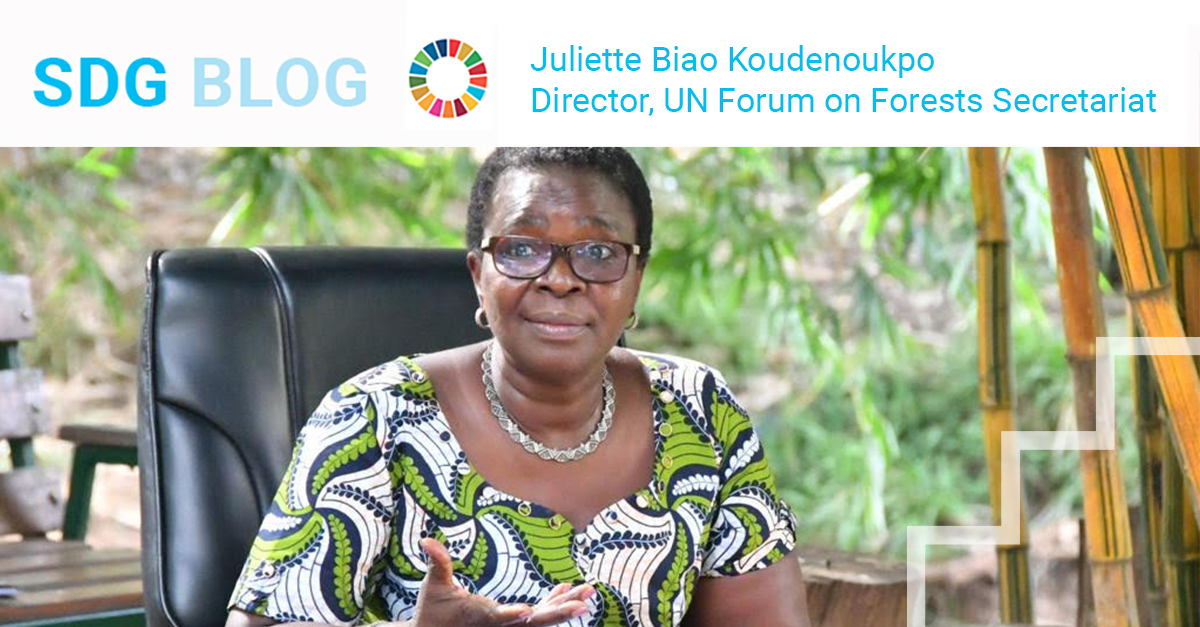SDG Blog

Healthy forests offer a path to a better climate and greener future for all
By Ms. Juliette Biao Koudenoukpo, Director, United Nations Forum on Forests Secretariat, UN DESA
The world we live in is beset with crises of epic proportions – from the global pandemic that has upended life as we knew it, to the looming threats of irreversible climate change and biodiversity extinction, coupled with rising pollution and unsustainable consumption and production.
The COVID-19 pandemic has exposed systemic vulnerabilities and inequalities in our development paradigm. From negative trade and economic downturns to rising poverty and food insecurity – the pandemic has left no one unscathed and has put in jeopardy the hard-won progress the world had made towards sustainable development. It has been a stark reminder that our health is deeply interlinked with our environment. Zoonotic diseases typically emerge when natural landscapes are degraded as a result of resource extraction, large-scale deforestation, illegal trade in wildlife and climate change, and other stresses.
The global crises we face today are interlinked and mutually reinforcing. And the one common element in all of this - is us. Our planet is paying the price of our unstainable choices, and the way we consume natural resources is accelerating biodiversity loss and exacerbating climate change. A recent study found that governments around the world spend at least $1.8 trillion per year, about 2 percent of global GDP, on subsidizing industries that are harmful to our environment. Imagine the possibilities if these resources could be redirected towards nature-friendly policies?
Albert Einstein once said, “In the midst of every crisis, lies great opportunity.” And according to a Somali proverb “He who does not seize opportunity today, will be unable to seize tomorrow’s opportunity”. To move away from the dangerous precipice we are on, we must chart a new path, one that puts us back on track for achieving the 2030 Agenda and gives us hope for a better future. As a lifelong forester, I would put forth that healthy, well-managed forests are one such pathway, and can be a solution to many, if not most, of the crises we currently face.
Forests cover 31% of our planet’s land area and provide habitat to 80 percent of all land-based species. Forest ecosystems regulate our global climate, rainfall patterns, and watersheds. They act as carbon sinks, absorbing about 2 billion tonnes of carbon dioxide annually. Sustainably managing the forests we have, and restoring the health of forests that are degraded, is critical to closing the emissions gap and regaining balance within our natural ecosystems.
Forests can help address many pandemic-induced challenges, including economic recession, increased poverty and widening inequalities. The forest sector has a proven track record in generating jobs that only require relatively low capital investment. In some countries, forests are already being employed as part of COVID-19 recovery plans through job creation in afforestation, reforestation, and agroforestry activities.
While forests support us and provide a safety net in times of need, they are also under threat. Deforestation, climate change, and forest fires, among others, continue to threaten the future of our forests. When Members of the UN Forum on Forests crafted the Global Forest Goals – the first goal they put forth was to put an end to deforestation and forest degradation, and a pledge to increase forests by 3% by 2030.
As populations continue to grow, it stands to reason that future demand for forest products and other natural resources will also grow, putting pressure on forest ecosystems. It is estimated that if we don’t change current consumption and production patterns, and if our population reaches 9.6 billion by 2050, we would need almost three planets to sustain us. We only have one planet, it is time we rebalanced the equation to be more efficient and thoughtful with resources we take and to make sure that the footprint we leave is as small as possible.
The issues we are grappling with today are not new and have been decades in the making. This year marks the fiftieth anniversary of the 1972 Stockholm conference, where the links between the environment, development, and poverty alleviation were recognized and placed at the forefront of the international agenda. In the past 50 years, we have had ample time to increase our knowledge, develop policies and reimagine the sustainable future we want. We have set our aim high through the 2030 Agenda, Global Forest Goals, Paris Agreement, and global biodiversity framework.
This month, as we celebrate the International Day of Forests on 21 March – let us plant the seeds of hope to reimagine a better future for forests, people, and planet. Let us not forget that it is not too late to take decisive action to reshape our shared future. If we join forces — governments, international organizations, the private sector, local authorities, and individuals alike - then we can create a world with more forests, richer diversity, less poverty, and a cleaner, healthier environment for all.
 Welcome to the United Nations
Welcome to the United Nations